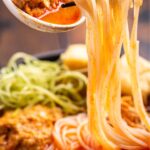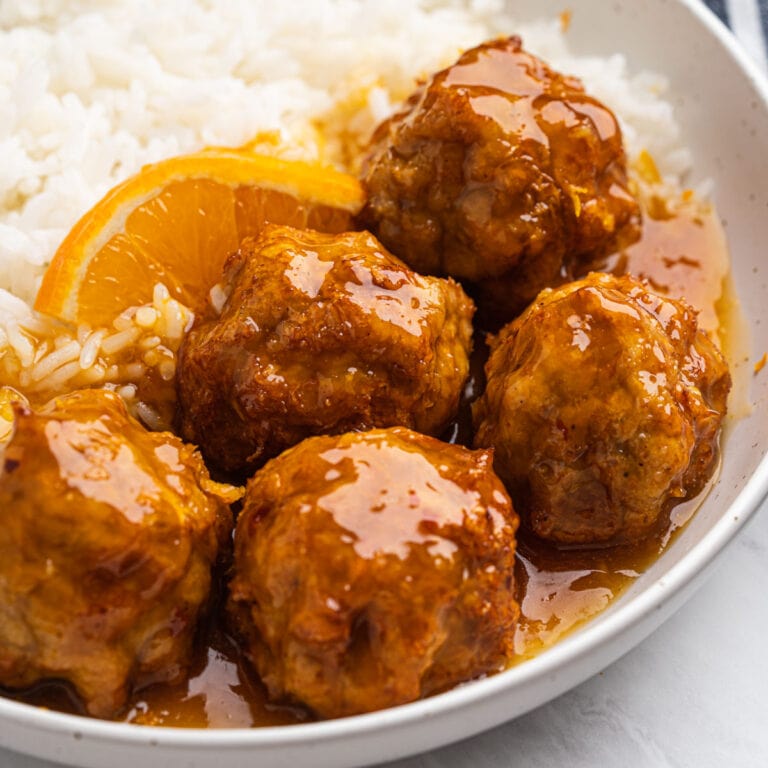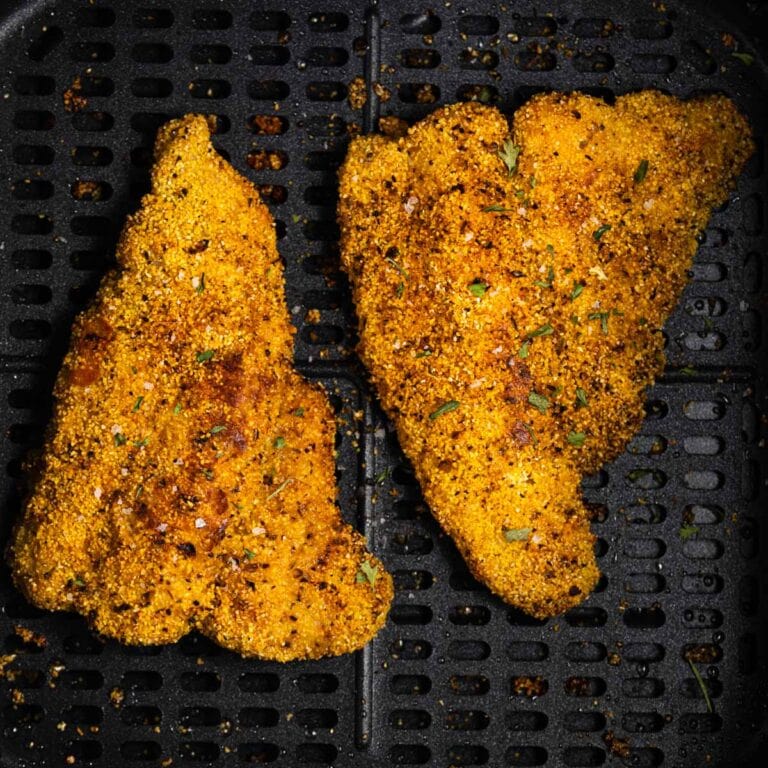Bún Riêu (Vietnamese Crab Noodle Soup)
Bun Rieu is a popular Vietnamese noodle soup dish known for its fragrant broth and unique combination of crab, shrimp paste, tomatoes, and rice vermicelli noodles. The crab and tofu soaks soak up all those incredible flavors. Finish it all off with a big handful of fresh herbs and a good squeeze of lime, and you’ve got a bowl of pure joy!

What is Authentic Traditional Bún Riêu?
Bún Riêu is a Vietnamese rice noodle soup featuring a broth infused with tomatoes and rice paddy crabs. The small rice paddy crabs are crushed into a paste, mixed with water, and then strained into a pot, leaving the shells behind. The resulting crab-infused water, now containing delicate crab meat fragments, is simmered to create a flavorful broth. The scant crab meat rises to the surface like sea foam, corresponding to the term “Riêu” in Vietnamese.
Is this Recipe Authentic?
Absolutely not! Unless you live in Vietnam, rice paddy crabs are hard to find. This bun rieu recipe takes a clever shortcut to achieve its rich flavor without the time-consuming process of making a traditional pork bone broth. Instead of simmering pork bones for an extended period, the broth is quickly infused with tomatoes and other aromatic ingredients.
This time-saving approach makes it an ideal choice for a weeknight meal, allowing you to enjoy the delightful flavors of this Vietnamese crab and tomato noodle soup without sacrificing taste or authenticity. The result is a quick and easy bun rieu soup that retains its delicious essence, perfect for those busy evenings when a comforting yet efficient meal is in order.
Why you’ll love this recipe
- Super flavorful: Bun Rieu is known for its rich, savory, and slightly tangy broth, which is incredibly flavorful thanks to the combination of crab or shrimp paste, tomatoes, and aromatic herbs. The complex taste profile is a major draw for food enthusiasts.
- Loaded with seafood: Minced crab and shrimp meat are added to the soup, making it a must-try for seafood lovers.
- Amazing textures: Bun Rieu offers a delightful textural contrast with the soft rice vermicelli noodles, tender tofu, and crunchy bean sprouts, creating a satisfying eating experience.
- Customizable: You can customize your noodle soup with a variety of fresh herbs, condiments, and garnishes. Adjust the flavor and spice level to your liking!
- Comfort Food: Bun Rieu is a comforting and hearty dish, perfect for warming up on a chilly day or satisfying hunger cravings.
Gather These Kitchen Tools
- Food processor
- Large mixing bowl
- Measuring cups and spoons
- Knife and cutting board
- Large stockpot
- Skillet or pan
Crab Paste or Shrimp Paste?
This is used to season the crab meatballs, and I use the oil from the paste to sauté the tomatoes to give them that vibrant red color.
Some people prefer one over the other; some add both. It’s really up to you! I’ve taste-tested a few that I found at my local Asian grocery store, and my favorites are #1, #4, and #5. Why am I giving so many options? This might be hard to find, depending on where you live. Read along and see which one you might like:

- Por Kwan Brand: Minced Crab In Spices – contains onion, garlic, 10% crabmeat, peanut, soybean oil, lemongrass, paprika, and MSG. The flavor is sweet compared to the rest. The texture is smooth, it’s not spicy, and there are visible chunks of onions (but soft).
- Por Kwan Brand: Bun Rieu Cua Spicy Crab Paste – the direction on the back says to put one spoonful of paste in 3 cups of water. It’s very concentrated and VERY salty. It contains onion, 15% crab meat, garlic, salt, soybean oil, tomato paste, MSG, and soy sauce powder. For a “spicy crab paste,” it wasn’t spicy at all. This was my least favorite.
- Pantai Brand: Shrimp Paste with Soya Bean Oil – It contains 50% shrimp meat, 35% soybean oil, garlic, salt, pepper, and MSG. It tastes exactly like minced dried shrimp in lots of oil, and after reading the ingredients, that’s basically what it is. Don’t be fooled by 50% shrimp! It’s very grainy and has no flavor. Be careful #3 and #4 look similar.
- Super Brand: Shrimp Paste with Soya Bean Oil – It contains soybean oil, garlic, 20% shrimp, MSG, soy sauce powder, salt, pepper, and paprika. I thought the flavoring was well-balanced. This is the one I ended up using.
- Por Kwan Brand: Minced Crab In Spices (canned) – It contains onion, garlic, 10% crabmeat, peanut, soybean oil, lemongrass, chili, sugar, MSG, salt, and paprika. I thought this one was well-seasoned but a tad spicy from the chili. The texture was smooth and velvety.
- Por Kwan Brand: Minced Prawn in Spices (canned) – It contains onion, 10% prawn, peanut, soybean oil, lemongrass, chili, sugar, MSG, salt, and paprika. It’s smooth with bits of shrimp that’s well seasoned and also a little spicy. The shrimp texture isn’t grainy or dry.
For this recipe, I used a mix of #4 (shrimp paste) and #5 (crab paste) for the crab meatballs and oils from the shrimp paste to sauté the tomatoes.
For the Crab and Tomato Broth

I combine chicken broth, water, rock sugar (or granulated sugar), chicken bouillon powder, and salt to prepare the broth. Next, I quarter the tomatoes and sauté them with shallots and a blend of cooking oil and the oil from the crab or shrimp paste, imparting the soup with its distinct red hue. Alternatively, ground paprika with oil or annatto oil can also be used to achieve the desired color.
It’s alright if you can’t fully separate the oils from the paste. I like using a bit of the paste to season the tomatoes.
Please scroll ⬇️ to the recipe card to see the full ingredient amounts and instructions.
For the Crab Meatballs

You’ll need ground pork, crabmeat, puréed prawns (or shrimp), rehydrated and chopped dried shrimp, eggs, and crab paste for the crab meatball. The correct consistency is key. There should be equal amounts of solid (pork, shrimp, and crab) to liquid (crab paste and eggs). The mixture should be moist but not overly liquid. If it is too runny, the meatballs may lose their shape when simmering in the broth, but you also want to avoid making it too dense.
Please scroll ⬇️ to the recipe card to see the full ingredient amounts and instructions.
Vermicelli (Bun) Noodles, Fried Tofu, and Vegetable Toppings


This is where you can customize it and make it your own! The base starts with rice vermicelli noodles (size small). Add fried tofu, shredded water spinach or cabbage, bean sprouts, Thai basil, mint, purple perilla leaves, lime, chopped scallions, and cilantro. Some people like adding fermented shrimp paste (mam tom) to the soup or as a dipping sauce. The possibilities are endless!
How to Make a 30 Minute Bun Rieu

Step 1: Soak the dried shrimp in hot water for 10 minutes to rehydrate. Use a food processor to chop it. Add it to a large bowl and set it aside.

Step 2: Use the food processor to purée the fresh prawn/shrimp to a paste.

Step 3: In a large bowl, mix the ground pork, shrimp, crab paste, dried shrimp, crabmeat, and eggs until well combined. Set it aside.

Step 4: Fill a large stockpot with chicken broth, 4 quarts of water, rock sugar, chicken bouillon powder, and fish sauce. Bring the broth to a boil and lower the heat to let it simmer.
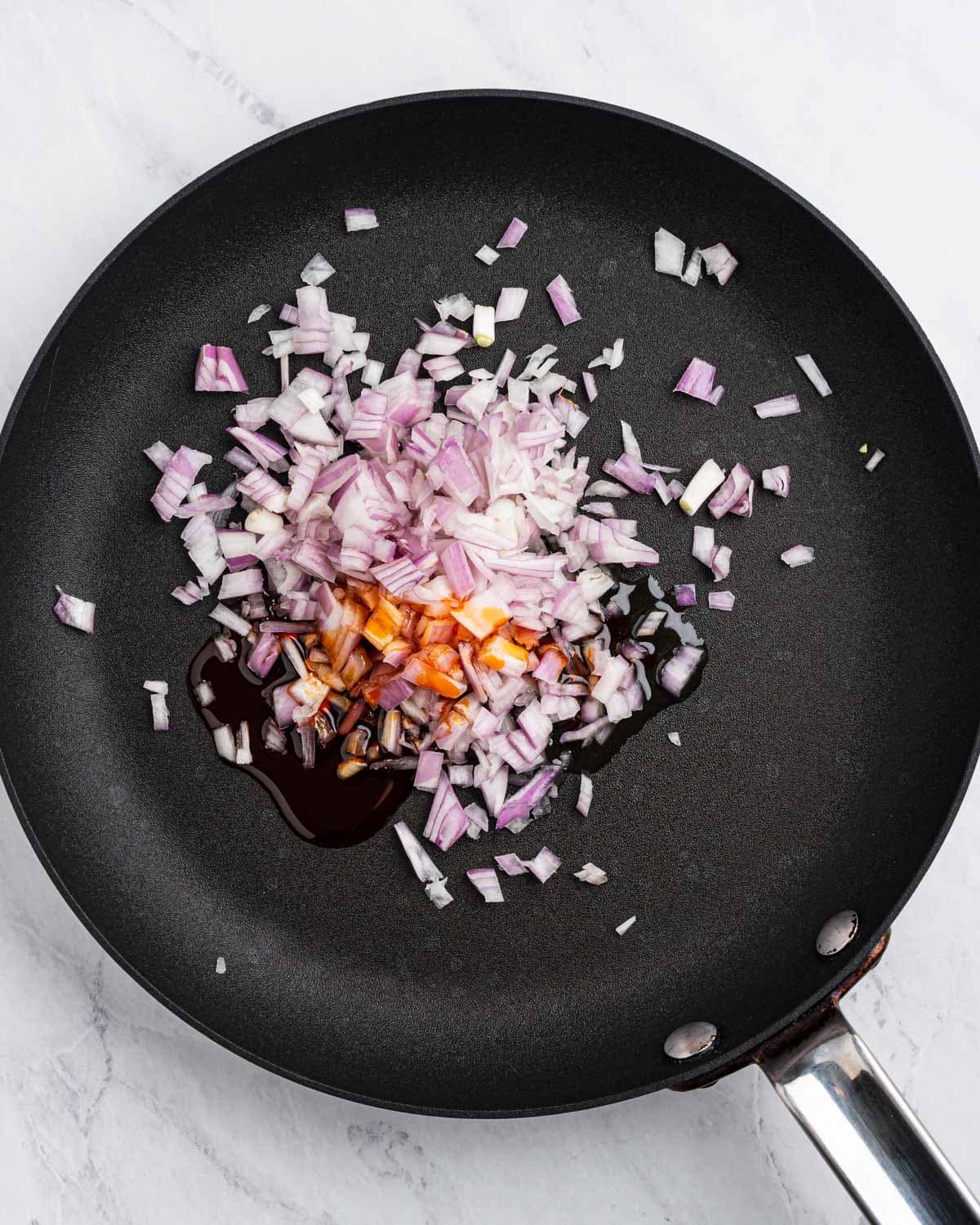
Step 5: Meanwhile, heat a skillet on medium-high heat until hot. Then, add vegetable oil, shrimp paste oil (or paprika), and shallots. Sauté until the shallot becomes fragrant and translucent, about 2 minutes.

Step 6: Add tomatoes and salt. Sauté for 2-3 minutes until they soften but still maintain shape.

Step 7: Add the sautéed shallots and tomatoes to the broth.
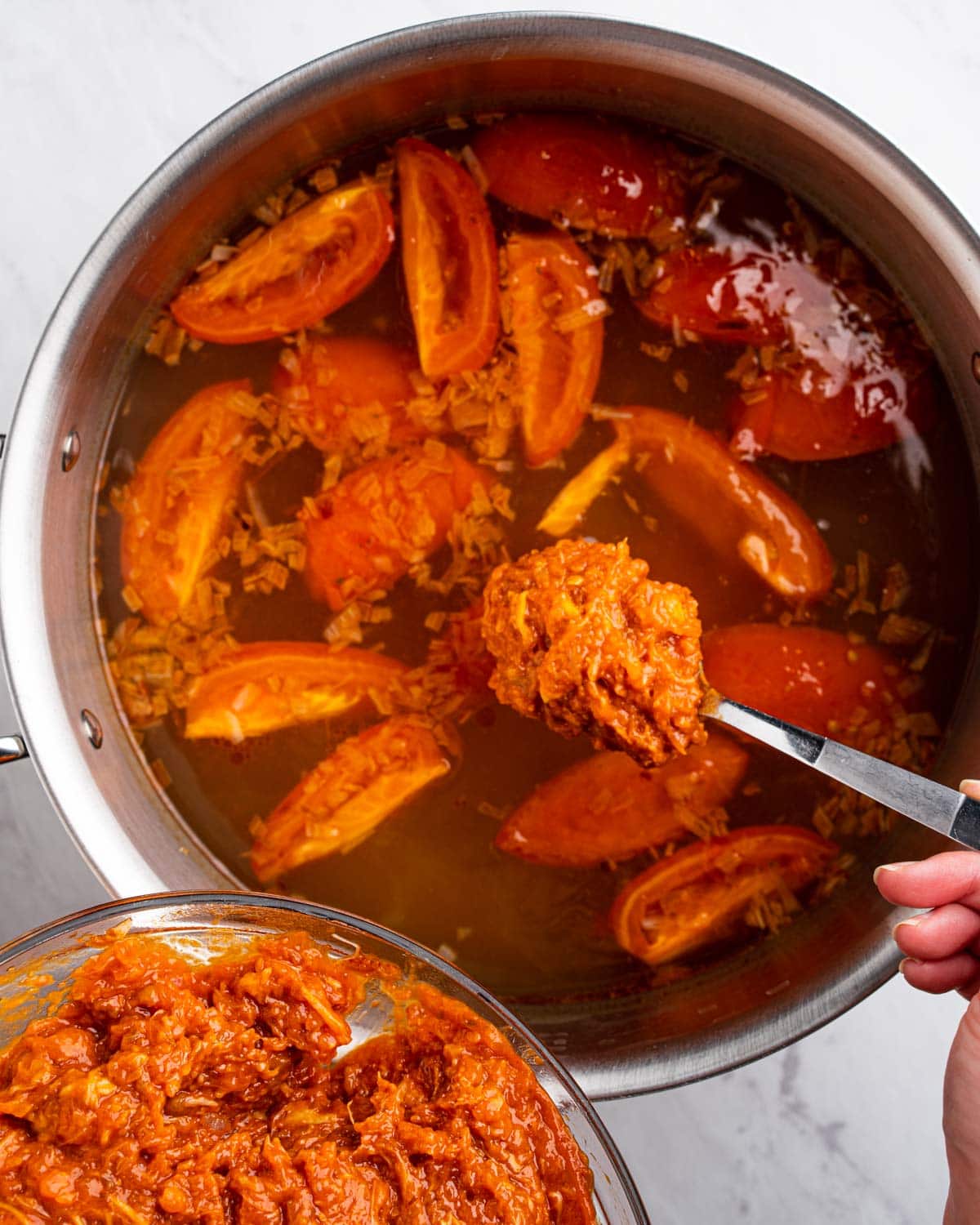
Step 8: Once the broth is boiling, scoop one heaping spoonful (about 1 1/2 tablespoons) of the crab meatball mixture into the boiling broth. Ensure that each spoonful is the same quantity so they all cook evenly. Let the broth simmer for an additional 10-12 minutes or until the crab meatballs are cooked through. Add more salt, rock sugar, or seasoning to the broth, if needed.
Ladle the hot broth onto cooked rice vermicelli noodles and serve it with your favorite toppings. Enjoy!

How to Serve it
Bun Rieu is served in large bowls to showcase the layers of ingredients and the flavorful broth. Place a portion of cooked and drained rice vermicelli noodles (bun) at the bottom of each bowl. The noodles serve as the base of the dish.
Ladle the hot bun rieu broth with crab and shrimp meatballs, tofu, and tomatoes over the noodles. Ensure each bowl has a generous amount of broth and ingredients.

Sprinkle a handful of fresh bean sprouts over the soup for a refreshing crunch. Add fresh vegetables and herbs like mint, Thai basil, purple perilla leaves, shredded morning glory stems (rau muong), shredded lettuce or cabbage, chopped cilantro, and chopped scallion. These herbs impart a burst of flavor and aroma to the dish.
Serve lime wedges, chili sauce, and fermented shrimp paste (mam tom) on the side or in small dishes. You can customize your own bowl by adding these condiments according to your preferences.
Tips for the best Bún Riêu
- Rice Vermicelli Noodles: Use high-quality rice vermicelli noodles and cook them just before serving to ensure they are tender and not overcooked.
- Simmering Time: Allow the broth to simmer for adequate time to extract flavors, but avoid overcooking the seafood.
- Taste Testing: Regularly taste the broth as you cook and adjust the seasonings as needed to achieve the desired flavor profile.
Frequently Asked Questions
Bun Rieu features a shrimp paste-based broth enriched with tomatoes and herbs. Minced crab or shrimp, tofu, and rice vermicelli noodles complete the dish, garnished with fresh herbs and condiments for a flavorful experience.
Pho and Bun Rieu are both Vietnamese noodle soups but differ significantly. Pho features a clear, aromatic beef or chicken broth with flat rice noodles, while Bun Rieu has a tangy, seafood-based broth with crab or shrimp, served with rice vermicelli noodles, and distinctively offers a shrimp paste.
Bun Rieu boasts a unique flavor profile—its broth is rich and tangy, with a hint of tomato sweetness. The minced crab or shrimp infuses a delightful seafood essence, while the rice vermicelli noodles offer a neutral base. It’s a harmonious blend of savory, sour, and umami flavors.
In Vietnamese, “Rieu” (also spelled “riêu”) refers to a type of small freshwater shrimp or prawn. It’s a key ingredient in Bun Rieu, the Vietnamese noodle soup dish, which often contains minced crab or shrimp meat, including these small shrimp, to impart a distinct seafood flavor to the broth.
Bun Rieu can be made gluten-free with certain adaptations to the recipe. The primary gluten-containing ingredient in traditional Bun Rieu is rice vermicelli noodles, typically made from rice flour and water and naturally gluten-free.
However, when preparing Bun Rieu at home or ordering it in a restaurant, it’s essential to ensure no gluten-containing ingredients or additives are used. Some variations of Bun Rieu may include ingredients like soy sauce or wheat-based condiments, so checking for gluten-free alternatives and verifying the preparation methods to accommodate a gluten-free diet is crucial.

How to Store Leftovers
Properly storing leftover bun rieu is essential to maintain its freshness and flavors. Firstly, let the soup cool to room temperature before refrigerating. Keeping the noodles and broth separate until you’re ready to consume is best.
Transfer it to an airtight container, ensuring it is large enough to accommodate the liquid without spilling. Seal the container tightly to prevent air exposure, which can lead to flavor loss.
Refrigerate
Refrigerate the leftover Bun Rieu within two hours of cooking. Consume it within 3-4 days to ensure the best quality.
Reheat
When you’re ready to eat it again, there are several ways to reheat it.
Stovetop: Transfer the desired portion of broth into a pot. Heat it over medium heat. Once it starts to boil, add the noodles, occasionally stirring to prevent sticking. Heat for about 2 minutes until everything is heated through.
Microwave: Place the desired amount of broth and noodles in a microwave-safe bowl. Reheat in 1-minute intervals, stirring in between, until the soup is thoroughly heated.
RECIPE

30 Minute Bún Riêu (Vietnamese Crab and Tomato Noodle Soup)
Equipment
- Food Processor
Ingredients
For the Broth
- 3 cups chicken broth
- 4 quarts water
- 2 tablespoons fish sauce
- 1 tablespoon mushroom or chicken bouillon powder
- 2 tablespoons rock sugar or granulated sugar
- 1 tablespoon vegetable oil
- 1 teaspoon shrimp paste oil (or paprika)
- 3 shallots or onions finely diced
- 4 tomatoes, quartered
- 1 teaspoon salt
For the Crab Meatballs (Riêu)
- 1 pound ground pork
- ½ pound prawn or shrimp (about 4-5)
- ¼ cup dried shrimp (rehydrated in hot water)
- 1 cup lump crabmeat
- 1 cup shrimp paste
- ½ cup crab paste
- 3 eggs
Noodles
- 1 pound dried rice noodles
Additional Toppings (Optional)
- 1 pound fried tofu
- ½ pound bean sprouts
- 1 bunch assorted vegetables (purple perilla, Thai basil, mint)
- 1 bunch morning glory (rau muong) or cabbage shredded
- lime wedges
- chopped scallions
- chopped cilantro
Instructions
- Soak the dried shrimp in hot water for 10 minutes to rehydrate. Use a food processor to mince it. Add it to a large bowl and set it aside.
- Use the food processor to purée the fresh prawn/shrimp to a paste.
- In a large bowl, mix the ground pork, shrimp, crab paste, dried shrimp, crabmeat, and eggs until well combined. Set it aside.
- Fill a large stockpot with chicken broth, 4 quarts of water, fish sauce, chicken bouillon powder, and rock sugar. Bring the broth to a boil and lower the heat to let it simmer.
- Meanwhile, heat a skillet on medium-high heat until hot. Then, add vegetable oil, shrimp paste oil (or paprika), and shallots. Sauté until the shallot becomes fragrant and translucent, about 2 minutes.
- Add tomatoes and salt. Sauté for 2-3 minutes until they soften but still maintain shape. Add the sautéed shallots and tomatoes to the broth.
- Once the broth is boiling, scoop one heaping spoonful (about 1 ½ tablespoons) of the crab meatball mixture and drop it into the broth. Ensure that each spoonful is the same quanity so they all cook evenly. Let the broth simmer for an additional 10-12 minutes or until the crab meatballs are cooked through. Add more salt, sugar, or seasoning to the broth, if needed.
- Ladle the hot broth onto cooked rice vermicelli noodles and serve it with your favorite toppings.
Notes
-
- I like sautéing the tomatoes with some shrimp or crab paste oil to give it flavor and color. It’s alright if you can’t fully separate the oils. A bit of the paste can be used to season the tomatoes.
- Use high-quality rice vermicelli noodles and cook them just before serving to ensure they are tender and not overcooked.
- Allow the broth to simmer for adequate time to extract flavors, but avoid overcooking the seafood.
- Regularly taste the broth as you cook and adjust the seasonings, as needed, to achieve the desired flavor profile.
